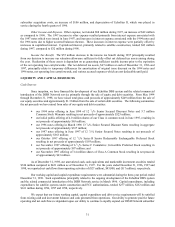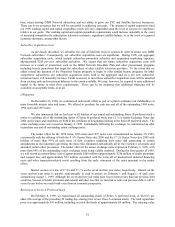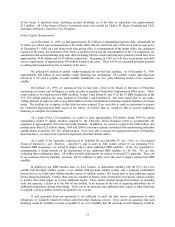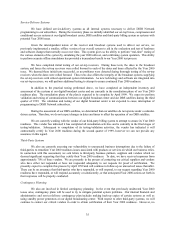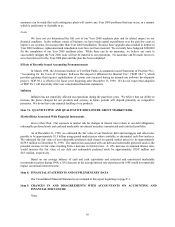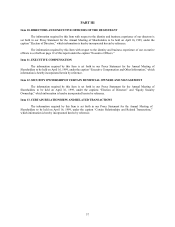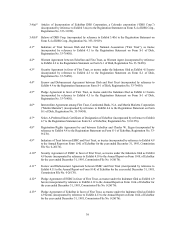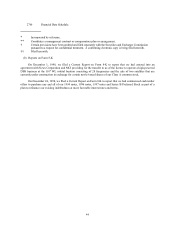Dish Network 1998 Annual Report Download - page 36
Download and view the complete annual report
Please find page 36 of the 1998 Dish Network annual report below. You can navigate through the pages in the report by either clicking on the pages listed below, or by using the keyword search tool below to find specific information within the annual report.34
sufficient to enable us to meet all of our obligations. We are required to retire the remaining 1994 notes, 1996 notes,
1997 notes and senior exchange notes when they mature, and the indentures governing the 1994, 1996 and 1997 notes
will remain outstanding (although with substantially all of the restrictive covenants having been eliminated) until such
time.
Year 2000 Readiness Disclosure
We have assessed and continue to assess the impact of the Year 2000 issue on our computer systems and
operations. The Year 2000 issue exists because many computer systems and applications currently use two-digit date
fields to designate a year. Thus, as the century date approaches, date sensitive systems may recognize the year 2000 as
1900 or not at all. The inability to recognize or properly treat the year 2000 may cause computer systems to process
critical financial and operational information incorrectly. If our Year 2000 remediation plan is not successful or is not
completed in a timely manner, the Year 2000 issue could significantly disrupt our ability to transact business with our
customers and suppliers, and could have a material impact on our operations. Even if our Year 2000 remediation plan
is successful or completed on time, there can be no assurance that the systems of other companies with which our
systems interact will be timely converted, or that any such failure to convert by another company would not have an
adverse effect on our business or operations.
We have established a five-phase plan to address potential Year 2000 issues:
• Inventory – the identification of all relevant hardware, embedded software, system software and
application software to establish the scope of subsequent phases;
• Assessment – the process of evaluating the current level of Year 2000 readiness of all components
identified in the inventory phase, defining actions necessary to retire, replace or otherwise correct all
non-conforming components and estimating resources and timelines required by action plans;
• Remediation – the correction of previously identified Year 2000 issues;
• Validation/testing – the evaluation of each component’s performance as the date is rolled forward to
January 1, 2000 and other dates and times relating to the Year 2000 issue; and
• Implementation – the process of updating components and correcting Year 2000 issues in the
production operating environment of a system.
In connection with this effort, we have segregated our computer systems and corresponding Year 2000
readiness risk into three categories: internal financial and administrative systems, service-delivery systems, and third-
party systems.
Internal Financial and Administrative Systems
With respect to our internal financial and administrative systems, we have completed the inventory phase of
the Year 2000 readiness plan by identifying all systems with potential Year 2000 problems. We are currently in the
process of assessing these systems by communicating with our outside software and hardware vendors and reviewing
their certifications of Year 2000 readiness, as well as reviewing internal custom programming codes. We expect to
have the assessment phase substantially completed by April 1999.
Upon completion of the assessment phase, we will begin the remediation and validation/testing phases.
During the remediation phase, we will attempt to correct all problems detected while performing the assessment phase.
During the validation/testing phase, we will create a parallel environment of all internal and administrative systems.
We will run tests on the parallel environment to assess its reaction to changes in dates and times relating to the Year
2000 issue. We currently expect the remediation and validation/testing phases to be complete by June 1999.
Once all known problems are corrected within the parallel environment, we will make changes to the actual
operating environment of our internal financial and administrative systems during the implementation phase. We
currently expect to complete the implementation phase by August 1999. Upon successful completion of the
implementation phase we will be able to certify our Year 2000 readiness. While there can be no assurance, we
currently believe that our internal financial and administrative systems are Year 2000 ready.









